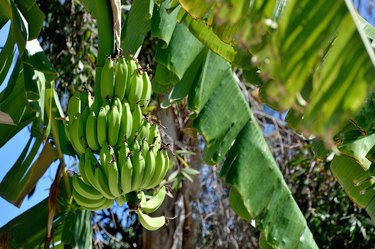
Bananas (Musa spp.) are among the world's most popular and widely sold fruits, available year-round in supermarkets across the globe. That very familiarity means we don't often expend much thought on them. We know vaguely that they're a tropical fruit that grows on trees, that they're easy to peel and have no seeds and that they're (mostly) yellow when ripe. In truth, bananas are pretty complex, and most of that is oversimplified at best, which is why banana kingdom taxonomy – its scientific naming – has been such a thorny issue for biologists over the years.
If bananas had a Facebook status, it would be "it's complicated." They're traditionally identified as Musa paradisiaca or Musa sapientum, but scientists now consider those names obsolete. The genus Musa has been retained, but a variety of other naming conventions has been proposed.
Video of the Day
Video of the Day
A Banana's Taxonomic Tree
The taxonomic tree is an organism's full (long-form) scientific name. In the case of bananas, it looks like:
- Domain: Eukaryota
- Kingdom: Plantae
- Phylum: Spermatophya
- Subphylum: Angiospermae
- Class: Monocotyledonae
- Family: Musaceae
- Genus: Musa
So, what does all of that mean? Well, the eukaryotes are living organisms whose cells have a nucleus. That includes every living thing you've ever seen with your naked eye, but it's a much, much smaller group than the microorganisms that make up the other two domains.
The classification of the banana from kingdom to species looks like this: The banana scientific kingdom is plants. Spermatophytes are plants that reproduce through seeds, angiosperms are plants that create their seeds from flowers and monocotyledons – or "monocots" for short – have seeds that produce one initial leaf when they sprout (dicots have two). The family is Musaceae (helpfully known as the "banana family"), and the genus Musa indicates bananas themselves. Simple, right?
Problems With the Standard Taxonomy
This system was created by an 18th-century biologist, Carl Linnaeus, in an ambitious effort with two goals: classifying every living thing then known to exist and providing a structure robust enough to incorporate the ones that weren't yet known. Scientists examined living species for their specific similarities and differences and used those to slot them into existing classifications or to create new ones as needed. On the whole, the system worked pretty well for a few centuries until the discovery of genetics gave us a better tool to use than external similarities.
There were a couple problems with that model, though. One was that Linnaeus himself didn't think cultivated crops were species as such, given that they'd been heavily selected and modified by human intervention. The other was that much of this work was being done in isolation by scientists working from limited numbers of specimens collected from all over the world as opposed to living with the plants long term in their natural habitat (which makes it hard to understand which characteristics are meaningful). As it turns out, bananas are a notable example of the system's flaws.
Banana Kingdom Taxonomy: It's Complicated
Linnaeus himself supplied the original two names given to bananas, Musa paradisiaca and Musa sapientum, but those – as he knew – were not species as such but hybrids of true species. The terms also came to be applied respectively to plantains, which are normally cooked, and "dessert" bananas, which are normally eaten raw.
As more scientists came to live and work in the tropical countries where bananas originate, it was increasingly clear how problematic the whole mess really was. Edible varieties were traced back to the original wild species from which they were derived, mostly M. acuminata and M. balbisiana, but since supermarket bananas and plantains are all hybrids of those two and other wild ancestors, that doesn't really get us far in our search for meaningful naming conventions.
Eventually, scientists created a list of distinguishing characteristics from those two ancestors, assigned each one an identifying combination of letters and used those plus a commercial cultivar name to identify the actual banana variety being grown. The specific banana you see in your fruit bowl right now, for example, might be classified as Musa (AAA group Cavendish subgroup) 'Robusta.' It's still not a perfect solution, and there's a lot of debate about it within the scientific and banana-growing communities, especially as genetic analysis reveals the presence of previously undetected wild ancestors, but it mostly works.
Some Fun Banana Facts
Hidden behind all the scientific controversy is a number of interesting facts about bananas that contradict the things you know about them. One is that they do still contain seeds – they're just so small that you don't notice them. Another is that they're considered by botanists to be a berry, just like tomatoes and eggplants. (Raspberries and blackberries, paradoxically, are not. Clearly, botany contains its share of contrarians).
Another notable fact you can drop into conversation is that banana trees aren't trees at all because they lack woody tissue. Banana plants are actually considered herbs and are related to ginger, galangal and turmeric. Like those close cousins, bananas grow from an underground root, or rhizome, but unlike them, the rhizome isn't the reason we grow them.
It's not even strictly true that bananas are a tropical-only fruit. Both edible and decorative varieties can be grown in subtropical areas, including the sunbelt states, and they can be grown in containers (and brought indoors when the weather cools) almost anywhere else.
- CABI: Invasive Species Compendium: Musa (Banana)
- Basic Biology: Taxonomy
- ProMusa: Linnaeus's Banana Legacy
- ProMusa: Modernizing Simmonds and Shepherd's Legacy
- ProMusa: Nomenclature System for Edible Bananas
- Healthline: Is a Banana a Berry or Fruit? The Surprising Truth
- ProMusa: Morphology of the Banana Plant
- Harvest to Table: How to Grow Bananas